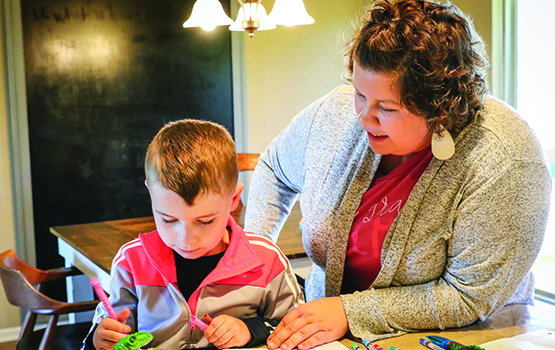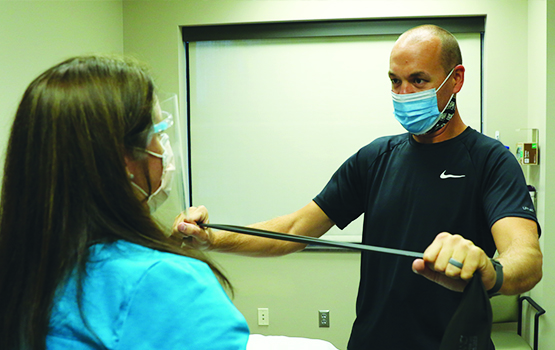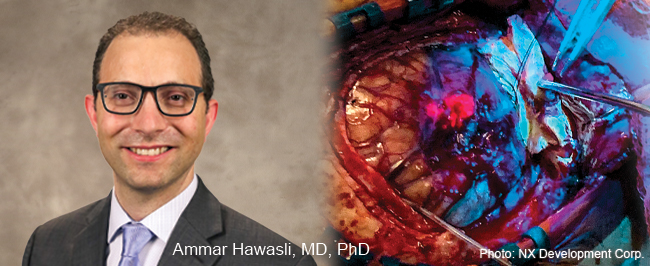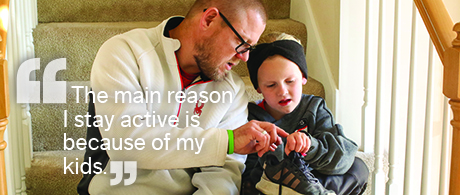Meet Ashley Mays
Teaching first grade and keeping up with a toddler takes patience, positivity and energy. In January 2020, Ashley Mays, then 30, had plenty of each to go around.
 “Life was good,” she recalled."My husband Chris and I were expecting our second child, and I felt really healthy and had a lot of energy."
“Life was good,” she recalled."My husband Chris and I were expecting our second child, and I felt really healthy and had a lot of energy."
Her second son Ford joined older brother Luke in March 2020. In May, Ashley discovered a lump in one of her breasts. “I assumed I had mastitis from breastfeeding,” she said. But when the lump didn’t go away with antibiotics, her obstetrician ordered a breast biopsy to rule out cancer.
I wasn’t concerned at all," Ashley said. "I don't have a family history of young people with breast cancer. My maternal grandmother was diagnosed when she was 75, but genetic testing showed no mutations. So when I found out I had breast cancer, I was completely shocked."
Ashley was diagnosed with Stage 3 invasive ductal carcinoma. She underwent chemotherapy, a lumpectomy and radiation. After treatment, Ashley started experiencing treatment-related back pain and fatigue.
In Ashley's Own Words
"My quality of life is so much better now."
Ashley shares her inspirational story of how cancer rehab helped her get back to a normal life.
"My level of fatigue was unreal," Ashley said. "I was home with the boys, and by the time Chris got home from work, I would be in tears. I couldn't believe my quality of life."
Her oncologist referred her to NKCH’s Cancer Rehabilitation and Wellness program for help managing her side effects.
"We created a therapy plan that included walking, weight training and core exercises," said Michelle McCullough, PT. "We focused on rebuilding Ashley's strength and endurance so she could do the things she wanted to do."
Ashley headed back to the classroom this past August. "This year, I teach 21 first graders and have enough energy to be with them all day, and then play with my boys at home," she said.
"My quality of life is so much better now,"Ashley added. "I thought I'd never get back to this point. Without the Cancer Rehab program, I'd still be struggling with fatigue. I live a pretty normal life now."
Meet William Pettit
When William Pettit first noticed the lump on his neck in May 2020, he didn’t think much of it. “Looking back, I remember feeling more tired than usual after my 60-mile bike rides,” recalled the active father of two energetic children.
 William waited until August to tell his wife Mary Jo about the lump. She made an appointment for him with her primary care doctor, who ordered a computed tomography, or CT, scan for the same day. Additional testing confirmed Stage 4 head and neck squamous cell carcinoma.
William waited until August to tell his wife Mary Jo about the lump. She made an appointment for him with her primary care doctor, who ordered a computed tomography, or CT, scan for the same day. Additional testing confirmed Stage 4 head and neck squamous cell carcinoma.
“I was told I wouldn’t survive surgery and that I had six to nine months to live,” William said.
William and Mary Jo knew that was not the ending to their story. They decided to move forward with the surgery despite the risk. “I told the surgeon I was ready to die trying,” he said.
During the 10-hour surgery, surgeons removed 38 lymph nodes. In the recovery area, William had a stroke that left him temporarily paralyzed on his right side.
In William's Own Words
"I was ready to die trying."
William shares his emotional story about how cancer rehab helped him return to his active lifestyle after a devastating diagnosis.
He was barely able to walk, talk or swallow. Yet, because the surgeons could not remove all the tumors, he had to prepare for seven weeks of chemotherapy and 35 radiation sessions.
“I told my oncologist I wanted to be active and have the quality of life I had before cancer,” William said. “He referred me to NKCH’s Cancer Rehab and Wellness program.”
Usually, patients are referred to the program after they finish treatment. “Because William was referred early, we got to follow him through his entire course of treatment,” said Brenda Ruhnke, OTR/L, CHT, CLT. “As new symptoms or side effects appeared, we were there to help him immediately.”
Over the next year, William worked to rebuild his strength and endurance. He’s back to work and enjoying an active lifestyle.
“My therapists were always positive and willing to listen and answer my questions,” William said. “I wouldn’t be where I am today if I had waited to begin therapy.”
Related Articles

March 9, 2020
3 Sneaky IBS Triggers
For people with irritable bowel syndrome, spring may spark a flare-up in symptoms

May 31, 2024
5 Nutrition Tips for a Healthier Lifestyle
Healthy eating and proper nutrition play a big part in maintaining good health. Here's how to improve your nutrition habits.

July 8, 2021
5-ALA Fluorescence Guides Neurosurgeons for More Complete Resections
Neurosurgeons Ammar Hawasli, MD, PhD, and Stephen Reintjes Jr., MD, with Meritas Health Neurosurgery, are now using a progressive treatment that allows for the more precise removal of malignant gliomas and glioblastomas.


